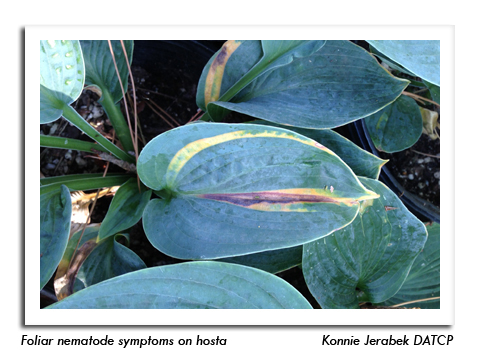
 |
|
|
Nursery & Forest
Volume 65 Number 16 Date 08/20/2020 HOSTA FOLIAR NEMATODE - Long, brown leaf streaks caused by foliar nematodes were observed on multiple hosta varieties in Juneau and Walworth counties. These nematodes are readily transmitted by water splash and through vegetative propagation, and have become increasingly common in the nursery trade. Although infestation is rarely lethal to host plants, the nematodes reduce overall vigor and can make hostas unsightly and unmarketable. Replanting susceptible stock in areas recently infested with nematodes should be avoided since the nematodes can temporarily survive in soil. Cuttings from infected stock should never be used for propagation, and decontamination of tools following contact with plants suspected of being infected is good practice. Chemical control is not effective against this pest. JUMPING WORMS - Nursery inspectors recently found invasive jumping worms in Walworth County nursery stock. The term 'jumping worms' refers to multiple species, all in the genus Amynthas. This damaging Asian pest, named for its unusual thrashing behavior when disturbed, was first detected in the state in 2013. The 1.5 to 8-inch long worms can be identified by the smooth, whitish non-segmented band around the body (clitellum). Other common worm species have a raised band. Jumping worms reproduce asexually and infest soil in high densities, altering soil texture and composition. Their feeding strips nutrients, kills plants, and increases erosion. A single worm can start a new population. Human-assisted dispersal by moving potted plants, soil, compost, mulch and fishing bait is a leading contributor to the spread of jumping worms. Actions recommended to reduce their spread include cleaning soil and debris from vehicles, equipment, gardening tools, and shoes before moving to and from a work site or recreational area. Gardeners and landowners who suspect they have jumping worms should keep any potentially infested plant, soil and mulch on site. These materials should not be sold, transplanted, or shared. More information can be found on the DNR website at: https://dnr.wisconsin.gov/topic/Invasives/fact/jumpingWorm.html. Sightings of jumping worms can be reported to the Wisconsin DNR by emailing invasive.species@wi.gov. OAK LACE BUG - Bur oak trees at a nursery in Grant County were heavily infested with this insect. Signs of infestation included dark, varnish-like excrement and cast skins on the undersides of leaves. Damage progresses to bronzing and early leaf drop under heavy lace bug pressure and is often most noticeable from mid- to late summer. The lace bug family consists of at least 27 species that feed on deciduous trees and shrubs. Most exhibit specific host preferences. Heavy feeding can reduce aesthetic quality, but normally does not harm the tree. JAPANESE BEETLE - Adults are still feeding on birch, elm, linden and many other varieties of nursery trees. DATCP surveys and inspections, as well as reports from the industry, suggest that the beetles have been a nuisance again this season, but populations are not as high as in the previous two years. NR 40 INVASIVE SPECIES - Amur cork tree, classified as a prohibited plant under the DNR Invasive Species Rule, was being sold at a nursery in Brown County. The "prohibited" category includes plants not yet found in the state, but if introduced, "are likely to survive and spread, potentially causing significant environmental or economic harm or harm to human health." Amur cork tree has distinct thick corky bark, and opposite and pinnately compound leaves that smell of faint citrus when crushed. The tree tolerates a wide range of sun exposure and soil types (clays to sands) and has the potential to invade Wisconsin forests. In addition to its fast growth displacing native species, amur cork tree is also allelopathic, which is an ability of the tree to exude chemicals from its roots that negatively impact the soil microbial community and surrounding vegetation. Amur cork tree is a prolific reproducer utilizing both seed (sexual) and root suckering (asexual) as means of dispersal. Additional information about the Department of Natural Resources NR 40 rule is available at: https://dnr.wi.gov/topic/Invasives/classification.html. FALL WEBWORM - Nests have become more common on nursery stock since July. The larvae inside are pale yellow with blackish lateral spots. Mature caterpillars develop tufts of silky hairs and are about one inch long. The fall webworm is a native species that feeds on over 120 different species of deciduous forest, shade, fruit, and ornamental trees, but avoids conifers. Manual removal of the webs is the preferred form of control. -- Tim Boyle and Shanon Hankin, DATCP Nursery Inspectors 

.jpg)

.jpg)
.jpg)
|
|
|